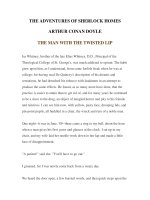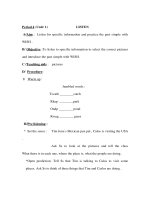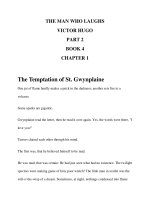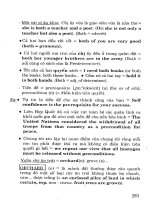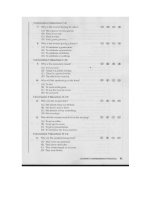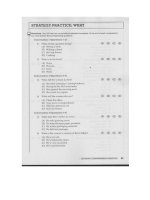4 6 1 ralph bunche quiet hero (biography)
Bạn đang xem bản rút gọn của tài liệu. Xem và tải ngay bản đầy đủ của tài liệu tại đây (2.57 MB, 6 trang )
Reader
Genre
Build Background
Access Content
Biography
• Equal Rights
• United States
History
• The United Nations
• Definitions
• Historical
Photographs
• Captions
• Fact Boxes
Extend Language
• Synonyms
Scott Foresman Reading Street 4.6.1
ì<(sk$m)=becbcf< +^-Ä-U-Ä-U
ISBN 0-328-14212-3
Talk About It
1. Who was the most important person in young
Ralph Bunche’s life?
2. Why was the United Nations created?
Write About It
3. Ralph Bunche helped change the ways people
in the world cooperate. On a separate sheet of
paper, write about some of the ways he did this.
Extend Language
Justice and fairness are synonyms. If you treat
someone with justice, you treat the person
with fairness. On page 4, a synonym for many is
numerous. How are their meanings similar?
Illustrations: 3 David Erickson
Photographs
Every effort has been made to secure permission and provide appropriate credit for photographic material. The
publisher deeply regrets any omission and pledges to correct errors called to its attention in subsequent editions.
Cover ©Bettmann/Corbis; Cover–8 (Bkgd) ©Getty Images; 1 ©Bettmann/Corbis;
2 ©AP Wide World Photos; 5 ©HWG/AP Wide World Photos; 6 ©Bettmann/Corbis;
7 ©Bettmann/Corbis; 8 ©Bettmann/Corbis.
ISBN: 0-328-14212-3
Copyright © Pearson Education, Inc.
All Rights Reserved. Printed in the United States of America.
This publication is protected by Copyright, and permission should be obtained from
the publisher prior to any prohibited reproduction, storage in a retrieval system,
or transmission in any form by any means, electronic, mechanical, photocopying,
recording, or likewise. For information regarding permission(s), write to: Permissions
Department, Scott Foresman, 1900 East Lake Avenue, Glenview, Illinois 60025.
Editorial Offices: Glenview, Illinois • Parsippany, New Jersey • New York, New York
Sales
Massachusetts
• Duluth,
Georgia • Glenview, Illinois
1234
5 6 7Offices:
8 9 10 Needham,
V0G1 14 13
12 11 10 09 08
07 06 05
Coppell, Texas • Sacramento, California • Mesa, Arizona
Ralph Bunche
received the
Nobel Peace
Prize in 1950.
Ralph Bunche was a man dedicated to peace
and justice. He was born in Detroit, Michigan,
in 1903. Ralph grew up in the home of his
grandmother Lucy Johnson. He called her Nana.
Nana was very important to Ralph when
he was growing up. Later in his life, he wrote
an article called “My Most Unforgettable
Character.” It was about Nana.
Nana became even more important to Ralph
after his parents died when he was just thirteen.
Through all the sadness, Nana made sure Ralph
believed in himself and always did his best.
Nobel Peace Prize: prize awarded every year to a person
who has done important work for peace
2
Ralph’s grandmother,
Lucy Johnson, whom
he called Nana
Nana could see that Ralph was very smart. She
pushed him to work hard. At the University of
California at Los Angeles (UCLA) Ralph had the
best grades in the school.
At UCLA, Ralph also began to take an interest
in politics. He helped to bring students of
different races together to talk. He believed
people would get along better if they knew
more about one another.
Even as a college student, Ralph was
interested in making peace. He gave a speech
called “That Man May Dwell in Peace.” In the
speech, Ralph explained that there could not be
peace without justice.
politics: the work of government
justice: fairness, rightness
3
After graduating from UCLA, Ralph continued
his studies at Harvard University. Soon he became
a professor at Howard University. His love of
justice led him to work for civil rights for African
Americans. Ralph also traveled to numerous
countries around the world.
In 1937, Ralph traveled to South Africa to see
how people lived there. South Africa had many
diamond mines.
Ralph learned that the people who owned
the diamond mines were exploiting the workers.
The black South Africans did most of the hard,
dangerous work in the mines but were paid very
little. Ralph saw that many people had no justice,
and he wanted to help them.
Did You Know?
Civil Rights
Civil rights are rights that belong to all citizens and
are protected by the government. Often, civil rights
refer to the right to be treated equally. People
of different races, genders, and religions must be
treated fairly, according to laws.
professor: someone who teaches at a college or university
exploiting: taking advantage of others to get rich
4
For the next few years, Ralph Bunche
continued to learn about Africa. He became an
expert. In 1941, when World War II began, the
U.S. government needed to know more about
Africa. Ralph helped to collect the information.
After that, Ralph Bunche spent most of his
time in public service. He worked for the
government in Washington, D.C., for several
years. Ralph did
his job extremely
well and impressed
many people. Soon
he was given
more responsibility.
Ralph Bunche
was presented
the Outstanding
Citizenship
Award in 1949 by
President Truman.
public service: doing work to help people, as a
government worker
5
Ralph in his United
Nations office
When World War II ended, people around the
world realized that war had caused too much
suffering and death. So in 1945, leaders from
around the world formed an organization called
the United Nations (UN). Ralph Bunche helped
plan and organize the UN. He served as an
official at the UN for many years.
Ralph Bunche had skills that were useful at
the UN. He knew that people who were fighting
often avoided each other. Ralph was good at
getting people to talk when they did not want
to talk. He helped countries to stop fighting by
asking their leaders to be fair to each other.
Did You Know?
United Nations
The United Nations was established on October 24,
1945. Many countries in the world are part of the UN.
The main goals of the UN are to help countries avoid
wars and to support justice and rights for all people.
6
Ralph Bunche meeting with Israel’s Prime
Minister David Ben Gurion in 1949
For his work at the UN, Ralph Bunche was
awarded the Nobel Peace Prize in 1950. He
continued to work for peace through the UN
until he retired in 1970.
During that time, Ralph Bunche also worked
for justice for African Americans in the United
States. He worked with Dr. Martin Luther King, Jr.,
a civil rights leader. Ralph Bunche and Dr. King
believed in using non-violent methods to get
justice. On August 28, 1963, Dr. King spoke to
a crowd in Washington, D.C. He gave a speech
that became very famous in the Civil Rights
movement: “I Have a Dream.” Ralph Bunche also
spoke that famous day in Washington.
7
Talk About It
Ralph
Bunche
and
Dr. King
lead a
march
for civil
rights.
1. Who was the most important person in young
Ralph Bunche’s life?
2. Why was the United Nations created?
Write About It
3. Ralph Bunche helped change the ways people
in the world cooperate. On a separate sheet of
paper, write about some of the ways he did this.
Extend Language
Two years later, Dr. King and Ralph Bunche
marched again. They marched for civil rights
in Alabama. Ralph Bunche had a disease that
made it very painful for him to walk, but he kept
walking. At the end, he spoke to the crowd,
along with Dr. King.
Dr. King and Ralph Bunche were two leaders
who loved justice. They marched side by side to
make the world a better place.
Justice and fairness are synonyms. If you treat
someone with justice, you treat the person
with fairness. On page 4, a synonym for many is
numerous. How are their meanings similar?
Illustrations: 3 David Erickson
Photographs
Did You Know?
The Civil Rights Marches
Leaders such as Dr. Martin Luther King, Jr., organized
peaceful marches to demand justice. Many people
would gather at one place and march through the
streets. They would carry signs asking for justice
and for civil rights. On March 21, 1965, 3,200 people
started a march in Selma, Alabama. Five days later,
when they reached Montgomery, Alabama, there
were 25,000 people marching.
Every effort has been made to secure permission and provide appropriate credit for photographic material. The
publisher deeply regrets any omission and pledges to correct errors called to its attention in subsequent editions.
Cover ©Bettmann/Corbis; Cover–8 (Bkgd) ©Getty Images; 1 ©Bettmann/Corbis;
2 ©AP Wide World Photos; 5 ©HWG/AP Wide World Photos; 6 ©Bettmann/Corbis;
7 ©Bettmann/Corbis; 8 ©Bettmann/Corbis.
ISBN: 0-328-14212-3
Copyright © Pearson Education, Inc.
All Rights Reserved. Printed in the United States of America.
This publication is protected by Copyright, and permission should be obtained from
the publisher prior to any prohibited reproduction, storage in a retrieval system,
or transmission in any form by any means, electronic, mechanical, photocopying,
recording, or likewise. For information regarding permission(s), write to: Permissions
Department, Scott Foresman, 1900 East Lake Avenue, Glenview, Illinois 60025.
1 2 3 4 5 6 7 8 9 10 V0G1 14 13 12 11 10 09 08 07 06 05
8

